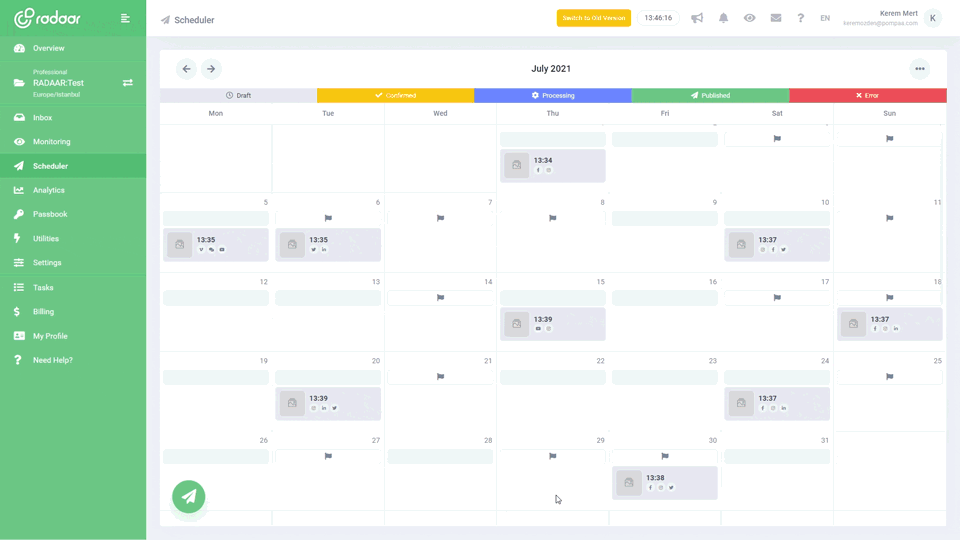Have you ever wondered if it's good to post on all social media at once?
Are you curious about whether blasting your content across all social media platforms simultaneously is a savvy strategy or a recipe for overload? Dive into our latest blog post to explore the pros and cons of this approach and discover insights to optimize your social media game.
LEARN MORE LAUNCH DEMO NOW In today's digitally connected world, social media platforms have become a fundamental part of our daily lives. Whether you're a content creator, business owner, or casual user, you've probably faced the conundrum of deciding when and where to post your content. With so many platforms available, from Instagram and Facebook to Twitter and TikTok, it's easy to wonder if blasting your content across all of them simultaneously is beneficial—or if it’s overkill. This question sparks a lively debate about the potential upsides and pitfalls of such an approach, and whether it truly optimizes reach and engagement.
On the one hand, posting on multiple platforms at once can seem like a surefire way to maximize visibility; the more eyes on your content, the better, right? However, each platform has its unique audience and algorithm nuances, raising questions about the effectiveness of this strategy. Additionally, some argue that varied posting times, tailored messages, and platform-specific content may lead to more meaningful interactions. In this blog post, we dive deep into the intricacies of multi-platform posting, weighing practical tips, expert insights, and real-world experiences to help you decide whether this approach fits your social media strategy.
On the one hand, posting on multiple platforms at once can seem like a surefire way to maximize visibility; the more eyes on your content, the better, right? However, each platform has its unique audience and algorithm nuances, raising questions about the effectiveness of this strategy. Additionally, some argue that varied posting times, tailored messages, and platform-specific content may lead to more meaningful interactions. In this blog post, we dive deep into the intricacies of multi-platform posting, weighing practical tips, expert insights, and real-world experiences to help you decide whether this approach fits your social media strategy.
Table of Contents
- Is it beneficial to maintain a uniform presence?
- Does it lessen the impact of your post?
- How does it affect your engagement with followers?
- Does it diminish the content uniqueness appeal?
- How does it affect brand consistency across platforms?
- Does it result in overexposure and follower fatigue?
- What could be better alternatives to simultaneous posting?
- How can you strategically plan your social media posts?
- Re-thinking your strategies in multi-platform social media posting: Is it worth the effort?
Is it beneficial to maintain a uniform presence?
Maintaining a uniform presence across all social media platforms can indeed be beneficial, particularly for establishing a cohesive brand identity. By sharing similar content across different platforms, you reinforce your brand message and make it easily recognizable to your audience, regardless of where they encounter it. This consistency can help in building trust with your audience, as it signals professionalism and reliability. However, while keeping your brand message uniform, it's crucial to tailor your content to fit the unique characteristics and audience expectations of each platform to maximize engagement.
Moreover, having a strong and uniform presence on multiple platforms increases your visibility and reach, allowing you to tap into a broader audience. Each platform has its own unique audience demographic, and by being active on all, you ensure that you're not missing out on potential connections. Additionally, cross-platform presence can improve your SEO, as it creates multiple backlinks to your primary online presence, like a website or blog. However, it's important to manage your efforts to avoid overextending, ensuring you maintain quality interactions and content, rather than just quantity.
Moreover, having a strong and uniform presence on multiple platforms increases your visibility and reach, allowing you to tap into a broader audience. Each platform has its own unique audience demographic, and by being active on all, you ensure that you're not missing out on potential connections. Additionally, cross-platform presence can improve your SEO, as it creates multiple backlinks to your primary online presence, like a website or blog. However, it's important to manage your efforts to avoid overextending, ensuring you maintain quality interactions and content, rather than just quantity.
Does it lessen the impact of your post?
Posting on all social media platforms simultaneously can sometimes lessen the impact of your content, as each platform has its unique audience and optimal posting time. When you share the same message across all channels at once, it may appear less tailored and engaging, resulting in lower audience engagement. By staggering your posts and customizing content for each platform, you cater to the distinct user behaviors and preferences, enhancing the chances of your message resonating. Additionally, spreading out your posts can prevent oversaturation, keeping your audience interested and engaged without feeling overwhelmed.
How does it affect your engagement with followers?
When you post on all social media platforms at once, you might initially think you're maximizing your reach, but it can actually have mixed effects on your engagement levels with followers. On the positive side, posting simultaneously ensures that your content is seen by followers regardless of their preferred platform, potentially increasing overall visibility. However, engagement is not just about how many people see your content but also how they interact with it. Different social media platforms cater to varied audience behaviors and content types; what works on Instagram may not resonate the same way on Twitter or LinkedIn.
Additionally, each platform's algorithm has its own quirks, which can result in differing engagement outcomes. By posting the same content everywhere at once, you may miss the opportunity to tailor your message to suit the unique audience and style of each platform, leading to reduced interaction. Followers might also notice repetitive content across platforms, which can make them feel less inclined to engage. To boost engagement effectively, consider customizing your content for each platform, experimenting with different posting times, and actively engaging with comments and messages.
Additionally, each platform's algorithm has its own quirks, which can result in differing engagement outcomes. By posting the same content everywhere at once, you may miss the opportunity to tailor your message to suit the unique audience and style of each platform, leading to reduced interaction. Followers might also notice repetitive content across platforms, which can make them feel less inclined to engage. To boost engagement effectively, consider customizing your content for each platform, experimenting with different posting times, and actively engaging with comments and messages.
Does it diminish the content uniqueness appeal?
When you post the same content across all social media platforms simultaneously, there's a risk that the content's uniqueness may be watered down. Each social media platform has its own culture, audience, and expectations, and what resonates on one may feel out of place on another. By tailoring your content to fit the distinct vibe of each platform, you can maintain its originality and cater more precisely to each audience's preferences. Ultimately, creating varied content that aligns with the unique nuances of each platform can enhance engagement and make your posts more impactful.
How does it affect brand consistency across platforms?
Maintaining brand consistency across multiple social media platforms can significantly enhance your brand's recognition and reliability. By posting simultaneously on all platforms, you ensure that your audience receives a unified message, which strengthens your brand identity and keeps your narrative clear and coherent. This consistency helps build trust because your followers feel they are engaging with the same brand tone and values, no matter where they find you. However, it's crucial to tailor your message to fit the unique features and audience expectations of each platform, ensuring that your brand’s essence shines through in a way that's both effective and engaging on every channel.
Does it result in overexposure and follower fatigue?
When considering posting on all social media platforms simultaneously, the potential for overexposure and follower fatigue is a significant concern. Constantly seeing the same content across multiple channels can overwhelm your audience, causing them to disengage or unfollow to avoid redundancy. Instead of feeling connected and engaged, they might start to view your posts as spammy, counteracting your efforts to build a positive brand relationship. It's important to strike a balance between maintaining a consistent presence and respecting your followers' desire for fresh, varied content.
What could be better alternatives to simultaneous posting?
Instead of posting on all social media platforms at once, consider tailoring your content for each specific audience to boost engagement. By scheduling posts at peak times when your followers are most active on each platform, you can increase visibility and interaction. Utilizing platform-specific features and trends, such as Instagram Reels or LinkedIn articles, can lead to better reach and more meaningful connections. Additionally, staggering your posts allows you to experiment with different messaging and visuals to see what resonates best with your unique audiences.
How can you strategically plan your social media posts?
Strategically planning your social media posts involves understanding your audience and tailoring content to fit each platform's unique culture. Start by analyzing your audience demographics and engagement patterns on different platforms, allowing you to schedule posts when your target audience is most active. Diversify your content to suit the strengths of each platform, whether it's catchy visuals for Instagram, informative threads for Twitter, or professional insights for LinkedIn. Utilize tools like social media calendars to organize and automate your posts, ensuring consistent engagement without overwhelming your followers.
Re-thinking your strategies in multi-platform social media posting: Is it worth the effort?
In conclusion, re-thinking your strategies in multi-platform social media posting can indeed be worth the effort, especially in our fast-paced digital world. By assessing the unique strengths and demographics of each platform, you can tailor your content to better engage with your audience, leading to stronger connections and increased brand loyalty. Instead of taking a one-size-fits-all approach, consider the nuances of each network—Instagram’s visual nature, Twitter’s real-time engagement, and LinkedIn’s professional focus, for instance. This deeper understanding can help you craft messages that resonate deeply with the right audiences, ultimately maximizing the return on your social media investment.
While it might seem more efficient to post the same content simultaneously across all platforms, it’s clear that a more personalized approach can yield better results. Analyze your analytics to identify where your audience spends the most time and adjust your strategy accordingly. Balancing consistency with customization may require more effort initially, but the payoff in engagement, reach, and community building can be substantial. So, take the time to rethink your multi-platform strategy—it might just be the key to transforming a scattergun approach into a finely tuned communication plan that amplifies your brand’s presence and impact online.
While it might seem more efficient to post the same content simultaneously across all platforms, it’s clear that a more personalized approach can yield better results. Analyze your analytics to identify where your audience spends the most time and adjust your strategy accordingly. Balancing consistency with customization may require more effort initially, but the payoff in engagement, reach, and community building can be substantial. So, take the time to rethink your multi-platform strategy—it might just be the key to transforming a scattergun approach into a finely tuned communication plan that amplifies your brand’s presence and impact online.
SOCIAL MEDIA SCHEDULER
Plan and publish...
Plan and publish your content for Facebook, Instagram, Twitter, and LinkedIn from one simple dashboard.
LEARN MORE FREQUENTLY ASKED QUESTIONS
What is social media management platform?
RELATED BLOG POSTS
All the tips & tricks you'll need...
Get the fresh tips and tricks you'll need to ace social media marketing.












